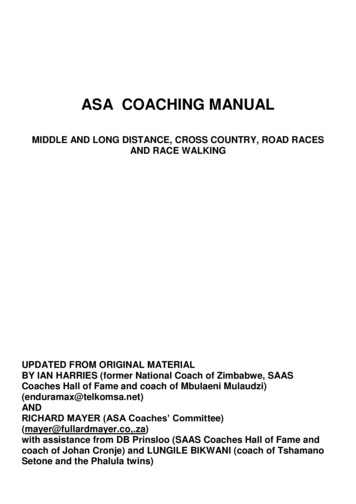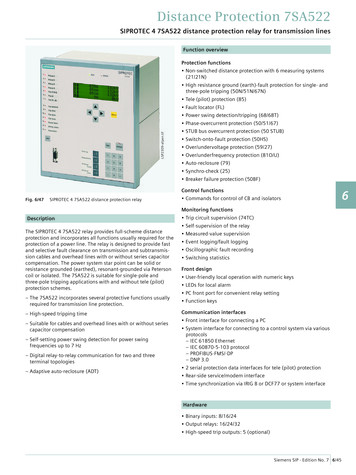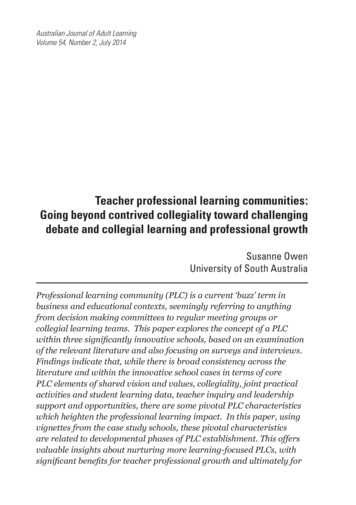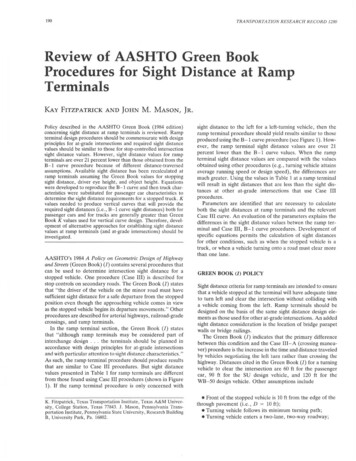
Transcription
39th NONPF Annual Meeting: Workshop PresentationGoing the Distance:A Recipe for SuccessDistance Education Program DeliveryJean DeMartinis, PhD, FNP-BCKaren Kalmakis, PhD, MPH, FNP-BCRaeann LeBlanc, DNP, ANP/GNP-BCJeungok Choi, PhD, MPH, RNSchool of Nursing
Pioneer Valley-- our TM pictureSchool of Nursing2
Background: Progress of DNP Program Launched DNP, 2006; entry PB-DNP and PM-DNP Full 5 Year CCNE accreditation, 2010 “Tweeked” /refined programmatic aspects andcurriculum formatively in response to consultants,students, faculty, and administrative feedback Entered whole program refinement phase 2012, weare in final phase this spring through fall 2013, inpreparation for CCNE CIPR Report Results of proposed DNP Program Revisions arepresented with “recipe” in Primer during WorkshopSchool of Nursing3
What We Did: Maximized Resources Used existing dwindling Expert Faculty resources within the SON Constantly reviewed Workload issues: Advising, Chair, Courseload, Cap for courses, etc. Drew on Interdisciplinary Resources: School of Public Health andHealth Sciences, Isenberg School of Management Coherence and Efficiency of resources was essential Closed our current MS APN role options Built DNP program on the foundation of the baccalaureatedegree in nursing Post Masters entry through Portfolio Review Process foradmission and placement into program is still the “GoldStandard” for PM placementSchool of Nursing4
What We Did: Post Baccalaureate PB to DNP Paradigm shift necessary for a practice doctorate:a “new” prototype for Nursing is essential Change in pedagogical thinking regardingsequencing of courses and content; Think: “What if an APN MS degree neverexisted?” (ex. MD model) Streamlined curriculum sequence initiated:foundation core offered EARLY in plan of study withadvancing core and role specialization courses overtimeSchool of Nursing5
Teaching Common Courses Across GraduateDegree Programs: DNP, CNL, PB-PhD Common Graduate level CORE content applied ineach equivalent Graduate level course acrossGraduate programs Foundation didactic and care core courses chosen tolaunch early—contain AACN Essentials knowledge,skills, and competencies—offered in first calendaryear of FT programs DNP level core and role courses launch later insecond and third years of FT program of studySchool of Nursing6
DNP Curriculum Revision 2006-2011:As everyone must—we moved and refined individualcourses and course sequencing from beginning 2012-2013: Time came for “whole” program/curriculum revision Offered more current courses in summer sessions Re-conceptualized our UMass Graduate School Requirement forComprehensive Examination Revised and advanced content and sequence of FNP and PHNL RoleOption courses to seamlessly advance students Reduced overall semester credits while ensuring 1000 direct andindirect practicum contact hours Revised Capstone Project development and actualization forseamless progression, more consistent faculty oversight, and to helpChairpersons lead candidates through Capstone Workshop review of Primer Outlining Curriculum RevisionSchool of Nursing7
Exemplars for Workshop Presentation Innovative Role Option curriculum considerations Exemplar--Public Health Nurse Leader; Presented by Dr. Kalmakis Workshop Q & A and comments Common Core Courses Across Graduate Degree Programs Exemplar—Informatics Dr. Choi- Present by Dr. Kalmakis with assistof Dr. LeBlanc and Dr. DeMartinis Workshop Q & A and comments Making the Connections: Advising DNP Studentsat a Distance--Exemplar—Presented by Dr. LeBlanc Workshop Q & A and comments Programmatic Challenges for DE Delivery Exemplars--Solving the Placement Puzzle and Reality of StateAuthorization Requirements; Presented by Dr. DeMartinis Workshop Q & A and commentsSchool of Nursing8
Innovative Role Option:Public Health Nurse LeaderProgressing through theDNP PHNL program:One step at a time for successin mastering complexPublic Health program plansPresented byDr. Karen Kalmakis, PhD, FNP-BC, MPHSchool of Nursing
CDC 10 Essentials of Public Health Service Monitor health status to identify and solve community healthproblems. Diagnose and investigate health problems and healthhazards in the community. Inform, educate, and empower people about health issues. Mobilize community partnerships and action to identify andsolve health problems. Develop policies and plans that support individual andcommunity health efforts. Enforce laws and regulations that protect health and ensuresafety. Link people to needed personal health services and assurethe provision of health care when otherwise unavailable. Assure competent public and personal health care workforce. Evaluate effectiveness, accessibility, and quality of personaland population-based health services. Research for new insights and innovative solutions to healthproblems.School of Nursing10
ANA Scope of Practice 6 standards of practice 10 standards of professional performance Define competency in public health nursing care,education, and research.School of Nursing11
Typical Program of Study PHNL Program Plan of Study framework in finalrevision Content of role courses will continue through Fall2013 Workshop review of current draft Plan of Study see Primer to follow along with discussionSchool of Nursing12
PHNL Role Concentration CoursesSequenceAdvanced Public Health Nursing I Didactic Introduction to the PHNL roleWhat is Public health nursingPopulation based nursing careCommunity assessment and needs assessment Importance Approaches Practicum Complete Community Assessment In community where student will work in subsequentpractica Identify public health needs in the communitySchool of Nursing13
PHNL Role Concentration Courses, cont.Advanced Public Health Nursing II Didactic Program planning using the information from thecommunity assessment students concentrate onprogram planning. Interventions Grant proposals Practicum Evaluation of an existing program in the communitySchool of Nursing14
PHNL Role Concentration Courses, cont.Advanced Public Health Nursing III:Contemporary Issues in Public Health Practice Didactic Health communication and advocacyCoalition buildingPrograms for vulnerable populationsGlobal health Practicum Implement a pilot of the program/interventionplanned in PHNL IISchool of Nursing15
DE Online format – Didactic Weekly readings Faculty guided discussions Assignments Written Class presentations (using voice, video, powerpoints)School of Nursing16
DE Online format – PHNL Role Practica Practicum experience (168 clinical contact hoursper role practicum course) Faculty lead course discussion Written assignments Journal self-reflection and Activity Time Log Preceptor/faculty guidance and evaluationSchool of Nursing17
One Student’s Journey Advanced Public Health Nursing I Community Large corporation Community Assessment Needs assessment – Hypertension/stress Advanced Public Health Nursing II Planned intervention : “A Public HealthIntervention to Increase the Practice ofResistance Training in an Employee Population” Evaluated current hypertension educationprogram in corporationSchool of Nursing18
One Student’s Journey (cont.) Advanced Public Health Nursing III Implementation of resistance trainingprogram Comprehensive Exam Final Capstone Scholarly Project "Lifestyle Modifiable Risk Factors forHypertension in an Employee Population"School of Nursing19
References American Nurses Association. (2006) PublicHealth Nursing Scope and Standards of Practice.American Nurses Association. The Core Public Health Functions SteeringCommittee, Center for Disease Control andPrevention. (2010). 10 Essential Public HealthSerices: http://w ww.cdc.gov/nphpsp/essentialservices.htmlSchool of Nursing20
Delivery of Common CoreCourses Across GraduateDegree ProgramsExemplar: Nursing InformaticsProduced byJeungok Choi, PhD, MPH, RNPresented byKaren Kalmakis, PhD, MPH, FNP-BC;Raeann LeBlanc, DNP, ANP/GNP-BC;and Jean DeMartinis, PhD, FNP-BCSchool of Nursing
Essentials of Doctoral Educationfor Advanced Nursing PracticeIV. Information Systems/Technology and Patient CareTechnology for the Improvement and Transformation ofHealth CareThe DNP graduate should be prepared: To apply advanced informatics knowledge,To manage individual and aggregate level systems’ information,To assess the efficacy of patient care technology appropriate to aspecialized area of practice,To design, select, and use information systems/technology toevaluate programs of care, outcomes of care, and care systemssuch as practice information systems and decision supports toimprove patient care.To be proficient in the use of information systems/technologyresources to implement quality improvement initiatives andsupport practice and administrative decision-making.School of Nursing22
Informatics for Nursing PracticeCourse Objectives: Evaluate the current status of information technology within healthcare. Apply information theories and models to the role of technology in healthcare. Compare the strengths and weaknesses of standardized terminologies in theirrepresentation nursing-related data. Describe the basic processes of computers, computer systems and types ofapplications and systems used in healthcare settings. Use databases and informatics tools to generate evidence from practice and toretrieve and analyze data, information and knowledge. Evaluate consumer health information sources for accuracy, timeliness, andappropriateness. Describe processes and methods associated with the development,implementation, and evaluation of healthcare information systems. Analyze selected healthcare informatics issues. Discuss the major issues of patient privacy and confidentiality, and systemsecurity related to the use of information, information technology,communication networks, and patient care technology.School of Nursing23
DE Course Assignments Assessment of informatics competenciesParticipation in threaded discussionsEvaluation of consumer health information websiteEvidence-based practice guideline implementationprojectSchool of Nursing24
Assessment of Informatics Competencies Purpose: For students, to learn the areas of competencies they need toimprove For instructor, to determine which areas of informatics needgreater focus in the design of better educational programs andgive valuable insight for informatics curriculum development.Self-Assessment Nursing Informatics Competency Scale (SANICS)(Yoon, Yen, & Bakken, 2009)SANICS is a 32-item self assessment tool to measures informaticscompetencies in five competency types (Clinical informatics role,Basic computer knowledge and skills, Applied computer skills,Clinical informatics attitudes, and Wireless device skills) with arating scale from 1 (not competent) to 5 (expert).Students take it at the first week and receive a summary of theresults arranged by the five competency typesSchool of Nursing25
Evaluation ofConsumer Health Information Website Choose 3 health-related web sites relevant to theirpatient care experiences through medlineplus.govand a general search engine such as Google, Bing,etc. Evaluate for content and literacy level using threereadability assessments (SMOG, Fry, Flesch-Kincaid)School of Nursing26
EBP Guideline Implementation Group Project The purpose of this group project is to identify components ofhealthcare information system implementation and to developevaluation methods as students work as a team for theselection and implementation of information system. Students break into groups of 4 to 5 to simulate a systemselection committee and complete a proposal for acomputerized evidence-based practice guidelineimplementation project. The project consists of an online presentation using Wimbavoice board and PowerPoint slides and an accompanyingwritten report. For a group work, three boards were created: Chat/Whiteboard(a synchronous system); Discussion board (an asynchronoussystem); and Wimba voice board (a synchronous system).School of Nursing27
Integrating Competenciesinto Informatics Course Integrating informatics competencies into the coursecurriculum is essential for adjusting the teaching method orcontent of the curriculum to the students’ various needs. Students’ competencies are measured at the beginning of thesemester and incorporated into course revisions. Example: in the 2010 fall course, the assessment findingsshowed students were not competent in decision-supportsystems nor in information literacy; thus, these two contentareas were strengthened by lecture notes and courseassignments, e.g., health literacy assessment of healthrelated web pages, a literature review on the impact ofdecision-support systems on health care practice,development of a proposal to design a decision supportsystems (Choi, & Zucker, In press).School of Nursing28
Integrating Informatics Competenciesinto DNP Curricula Preparing DNP students to be competent in all the areas ofinformatics competencies during one informatics course doesnot seem practical or efficient. Instead, informatics competencies need to be incorporatedinto the DNP curriculum in collaboration with other DNPinstructors For example, activities or exercises using spreadsheets,databases, and statistical software could be included in DNPcourses such as nursing research or intermediatebiostatistics, leadership, or health quality (Choi, &DeMartinis, in press)School of Nursing29
Integrating Informatics Competenciesinto Existing DNP Curricula: Examples Familiarizing students with statistical software for qualityimprovement projects can be incorporated into leadership orhealth quality courses. Using informatics tools such as retrieving data, information,and knowledge to investigate population health can beincorporated into an epidemiology course Using informatics tools to evaluate knowledge for evidencebased practice can be incorporated into a research methodcourse. Informatics skills could be incorporated into clinical practicumcourses in the DNP curriculum by applying point-of- caretechnologies for decision support and documentation. Administrative, clinical, and educational databases could beutilized in the planning and execution of the capstone project.School of Nursing30
Intermediate Biostatistics Many biostatistics courses are currently offeredacross the programs, all with a different scope. For example, the biostatistics courses in publichealth focus on principles of statistics to preparestudents as statisticians; thus, mathematicalequations and hand calculations are importantcomponents of course materials. On the other hand, statistics course in DNPprogram require applying statistical techniquesusing software to solve clinical problems andcomprehending basic statistical concepts.School of Nursing31
Course Objectives1. Create and manage a computerized databaseusing SPSS statistical software package2. Analyze the relations between research methodsand statistical techniques3. Select the appropriate statistical methods toaddress research questions4. Carry out an appropriate statistical procedures5. Interpret and analyze statistical outputs6. Write the results section of a research report.School of Nursing32
Course Description Focusing on statistical techniques frequently used inhealth sciences research and on the use of analyticsoftware to create, manage and analyze data on personalcomputers Making the course student friendly by minimizingmathematical symbolism and equations Emphasizing on the practical application of biostatistics innursing practice through hands-on practice with data setsand statistical software by assignments Students being able to utilize statistical knowledge andskills learned in the class when analyzing and interpretingtheir capstone project data.School of Nursing33
Course Content The course content consists of: Reading assignments in the course textbook, and additionalreadings Lecture notes with examples to accompany the readings Weekly computer exercise for individual practice anddevelopment of skills Students work weekly practice problem sets by: Generating their own research questions, Identifying appropriate statistical techniques, and runningsoftware (SPSS Standard GradPack ), Interpreting the findings, and Presenting results in laymen’s terms. Receiving graded assignments back with instructor’scomments to ensure they are on the right track.School of Nursing34
Topical Outline Review of concepts from introductory biostatistics: Descriptivestatistics and inferential statistics Measuring the differences among group means: t-Tests andOne-Way Analysis of Variance (ANOVA) Analysis of Covariance (ANCOVA) Repeated Measures Analysis of Variance (RM-ANOVA) Regression & Regression Diagnostics Correlations Logistic Regression Factor Analysis Nonparametric StatisticsSchool of Nursing35
References Yoon S, Yen PY, & Bakken S (2009). Psychometricproperties of the self-assessment of nursing informaticscompetencies scale. Stud Health Technol Inform., 146, 54650. Stud Health Technol Inform Choi, J. & Zucker, D. (In press). Self-assessment of nursinginformatics competencies for Doctor of Nursing Practicestudents. Journal of Professional Choi, J. & DeMartinis, E.J (In press). Nursing informaticscompetencies: Assessment of undergraduate and graduatenursing students. Journal of Clinical Nursing.School of Nursing36
Making the Connections:Advising DNP Studentsat a DistancePresented byRaeann LeBlanc, DNP, ANP/GNP-BCSchool of Nursing
The Advising Recipe for Success Appointment of advisors to adviseesReaching OutTimely & effective communicationOrganized & tracked plan of studyOrganizational processes in improving advisingfor distance students & facultySchool of Nursing38
Connecting Advisors & Advisees Starts at the beginning of the program as newstudents matriculate into program In-person, Skype, Telephone, Email Advisors/Students connect for initial introductionand then each semester, at a minimum, prior toregistration for the next semester’s courses. Connections and communication intensify as studentsfollow through comprehensive examination & capstoneScholarly project requirements toward graduation Required Record(s)of advising meetings on fileSchool of Nursing39
Reaching Out Pro-active response: Required of Advisee and Advisor Clarification of Role of Advisor: Assist student to navigate the program expectations asneeded Tracks advisee progress on timeline to graduation Provides for early intervention for academic orprogression challenges Links students with resources and services (editors,campus services) Serves as Chair of comprehensive exam & capstonescholarly project Provide supportive leadership through guidanceSchool of Nursing40
Timely & Effective Communication DNP Online Orientation Required DNP Graduate Program Office provides importantupdates regularly on DNP Listserve Communication goes both ways Clear expectations of when to contact advisor Red Flags—for Early Intervention Off track with plan of study Cumulative GPA less than 3.0 Specific concerns (writing, disabilities, professionalconduct) Incompletes, Withdrawals, & FailuresSchool of Nursing41
Organized & Tracked Plan of Study Plan of study on admission to program &updated each semester (see Primer) Students sign/agreement to adhere to plan Out of sequence issues addressed 6 Forms from pre-Comprehensive Examination tocompletion of Capstone Scholarly Project: (seePrimer)School of Nursing42
Organizational Processesfor Improving Advising Orientation for faculty on advising by DNPProgram Director and Program Manager (now wewill include Role coordinators as well) Advisor expected to be key contact person forassigned students for progress
DNP Curriculum Revision 2006-2011:As everyone must—we moved and refined individual courses and course sequencing from beginning 2012-2013: Time came for “whole” program/curriculum revision Offered more current courses in summer sessions Re-conceptualized our UMass











